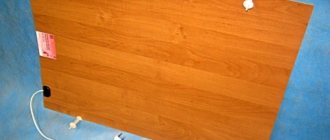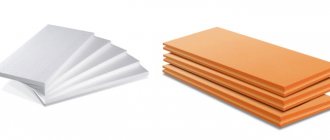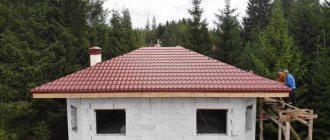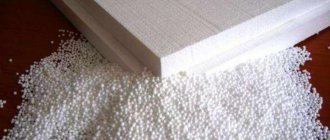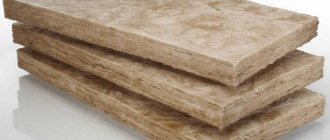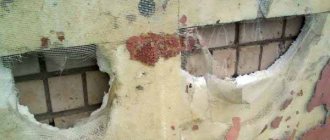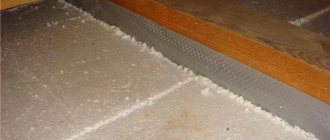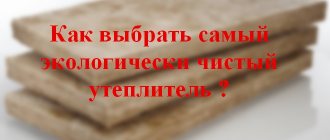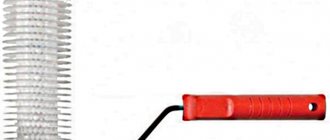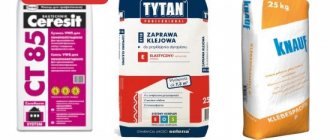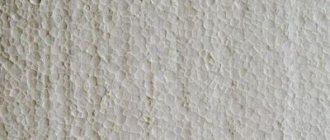Insulation of the walls of the house from the inside is necessary in cases where it is impossible to perform thermal insulation of the room from the outside - for example, on the loggia or in the basement. For this, PENOPLEX COMFORT ® boards are used. The use of this material will help insulate the loggia or the underground space of the house in accordance with modern heat engineering standards, as well as create a healthy and comfortable indoor climate.
Increasingly, modern builders recommend buyers to use penoplex for insulating their homes.
Penoplex with glue for penoplex gained its popularity not so long ago, because it was invented only in the middle of the last century, but during this time it spread throughout the world and began to occupy positions along with mineral wool, ordinary expanded polystyrene and other well-known materials for thermal insulation.
Penoplex in original packaging
However, you can often hear that there is harm from penoplex, and very significant. Is it really? Let's try to figure it out.
What should be the insulation?
Since there is no objective data on the allegedly harmful effects of penoplex on a person, we will figure it out ourselves.
When choosing a heater, many buyers, having familiarized themselves with the operational characteristics of the products of PENOPLEX SPb LLC, ask themselves the question: "Is penoplex not harmful to health?" Needless to say, there is a lot of talk about the harmful effects of penoplex, but let's try to figure it out. The selected insulation for structures or structures must meet the following requirements:
- the material used should not contain dust and small fibers, which confirms the inconsistency of statements about the dangers of foam for the house, since these factors are absent;
- phenol-formaldehyde resins and similar harmful substances are absent in the penoplex, which makes it possible to give a negative answer to the question: "Is penoplex harmful or not?";
- whether penoplex is not harmful to the environment and human health can be judged on the basis of the fact that in its production, means that destroy the ozone layer of the Earth are not used;
- when the insulation is operated from 50 degrees of frost to 75 degrees of heat, as recommended by the instructions for penoplex, there are no harmful emissions for humans, which is confirmed by the sanitary-epidemiological and environmental conclusion.
The influence of polystyrene on the environment and human health

Harmful substances affect the human nervous system
With proper installation, as well as with reliable protection from the influence of external negative factors, the molecular structure of the material does not change. Under normal conditions, the health hazard of expanded polystyrene is minimal.
The material is safe when used in the temperature range from -40 to +40 degrees. If it ignites, the person experiences the following health problems:
- irritation of the mucous membranes of the eyes, respiratory tract;
- dizziness and cough;
- fatal lung damage with high styrene concentration;
- development of oncological pathologies;
- violation of the functionality of the liver and kidneys, the nervous system.
To reduce the health harm of expanded polystyrene, you should not use it for roof insulation. If the roof is metal, it gets very hot under the influence of sunlight. In this case, there is a risk of styrene release to the surrounding area.


Food containers decompose from 80 to 400 years
If you use the product in a room with high humidity, after a while a fungus will grow in the walls. It destroys the foundation and negatively affects human health.A small child will be the first to react.
When choosing expanded polystyrene, environmental friendliness is the second issue that has been discussed for several years. Many experts say this material is harmful to the environment. The main danger lies in the following properties of the product:
- Poor moisture absorption. Since the disposal of used material is not always carried out according to the rules, a huge number of floating plastic “islands” can be found in the world's oceans.
- No oxidation. As a result, there are practically no decay processes in the insulation. Studies have shown that with proper use of the product, it does not lend itself to destruction for at least 60 years. For the environment, this is of great importance, since the material accumulates in landfills and pollutes the environment.
- Resistant to most solvents. This material can lie in a landfill for decades. Resistance to biodegradation causes litter fields to grow, polluting the land.
Collecting and recycling material is expensive and difficult. The cost of producing polystyrene from insulation is high. It is cheaper to get it from raw materials. It is possible to reduce the negative impact of the product on nature by using it in the production of building blocks.
Modern insulation Penoplex - myths and reality
The myths existing among consumers concern not only how much Penoplex is harmful to the human body, but also that a real house must "breathe". Unfortunately, only wood can provide natural microcirculation of air. A beautiful wooden house outside the city is wonderful, but how to build high-rise buildings from such material? In urban apartments - windows and supply and exhaust ventilation provide the necessary air exchange in the room. The alleged harm of penoplex in the house, which consists in the fact that it does not allow the walls of the house to breathe, only testifies in favor of its use, since a house built in accordance with modern requirements should be like a thermos.
But the "vapor permeability" of the walls is not only a myth, but a real misinformation, the harm of which is much greater than even talk about hypothetical harmful substances in the penoplex. It is simply impossible to imagine a multi-storey building, from the walls of which steam comes out on a frosty day. As a result, the walls would be covered with ice, and we would have to talk not about the harmful secretions of penoplex, but about the need to save residents from chronic colds.
A lot can be said about whether penoplex insulation is harmful to health. And we can only remember that the plates of expanded extruded polystyrene were used in the construction of a bathhouse at the international scientific station Novolazarevskaya in Antarctica, which indicates their environmental safety.
Is it burning or not?
Undoubtedly, modern insulating materials are subject to combustion. Therefore, there is a certain harmfulness of the foam for the body during the combustion of this insulation. At the same time, carbon monoxide and carbon dioxide are released, which poses a danger to humans. Ordinary solid fuel stoves in rural areas are just as dangerous, because in the absence of traction, carbon monoxide can cause death or severe poisoning. When using insulation in the middle of the brickwork or outside, reinforcing it on the walls, it is not necessary to talk about the health hazards of the insulation, since the question: "Is penoplex harmful during combustion?" it can be argued with full responsibility that burning foam is harmful, like wood, MDF boards, window structures. The statement that penoplex is harmful to the body, since when it burns, hydrocyanic acid and phosgene are released is not true.
Installation of house insulation can significantly reduce financial costs for space heating.Expanded polystyrene is especially popular among professional builders.
In everyday life, this material is most often referred to as foam.
The high popularity of this material makes one think about the question of whether expanded polystyrene is harmful to humans, especially when used as insulation indoors.
In order to understand whether it is dangerous for people to use this material as a heater, and what is its harm to the human body, one should figure out what it is and what the manufacturing technology is.
Outcomes
Styrofoam is widely used to insulate houses, although there is a safer and cheaper alternative - mineral wool. Polyfoam is harmful to human health. Even during normal use, it emits styrene, and at high temperatures, the concentration of styrene increases exponentially. In addition, regular and extruded foams are highly flammable. The process is accompanied by the release of thick smoke with a high content of toxins. Moreover, the cost of such heaters is twice as high as mineral wool.
Non-freezing liquid for heating systems warm house based on propylene glycol - it is not poisonous.
It is necessary to change the liquid for autonomous heating systems every two seasons. More details here.
That is, at a high price you get a highly flammable, poisonous insulation, the only advantage of which is simple installation. Living in a house insulated with foam is harmful and this harm should not be underestimated. We strongly do not recommend using this thermal insulation for interior work.
Expanded polystyrene - its composition and production technology
What is Styrofoam and what is it made of?
Expanded polystyrene is a gas-filled material. Its production is carried out by steam heating of specially prepared polystyrene granules.
Polystyrene is preliminarily subjected to a special treatment - its granules are filled with gas.
Depending on the purpose of the final product, natural gas or carbon dioxide can be used.
Carbon dioxide is used in the production of fire resistant material.
In the process of heating, the gas begins filling the granules and expands, which leads to an increase in the volume of the latter. The volume of granules can be increased by 15-30 times.
If the process is not restrained, then at the end of heating, a friable material is obtained, which is used to fill frameless furniture and as a bulk insulation during construction work.
If it is necessary to obtain solid polystyrene foam, foaming is carried out in an appropriate closed form.
In this way, polystyrene foam plates are made, which are used for wall cladding when insulating buildings.
When foaming the foam in a closed mold, a variety of decorative elements are also produced. Boxes for packaging various household items, etc.
This heat-insulating material has a number of advantages, the main ones of which are the following:
- the presence of a high degree of thermal insulation;
- the presence of a long service life of the material;
- low coefficient of water absorption;
- the presence of a low coefficient of vapor absorption;
- high degree of biological resistance;
- lack of attractiveness for the settlement of rodents and various parasites;
- a small mass of finished insulation.
Another significant advantage of this thermal insulation material is its low cost.
The harm of extruded polystyrene foam to the body
The basis for the production of extruded polystyrene foam is the use of special installations - extruders.
This equipment operates on the basis of the use of the extrusion principle, which consists in forcing a heated source material through narrow slots; during the production process, a heater is formed in the form of a plate.
The use of extruded polystyrene foam can cause significant harm to health. Especially the harm of this material is manifested when exposed to high temperatures. This is due to the fact that such toxic compounds are released from it as:
- vapors of styrene.
- Benzene vapors.
- Soot.
- Carbon dioxide.
- Carbon monoxide or carbon monoxide.
The combustion temperature of the main component of expanded polystyrene - styrene is about 1100 degrees Celsius.
The use of this material in construction is also harmful to the environment, this is due to the long decomposition of polystyrene, which is more than a hundred years. During the period of intensive use, which is about 20-25 years, the material undergoes significant wear and tear, which leads to a significant increase in the harmful effects on people.
During the period of intensive operation, the polystyrene plate releases up to 60% of decomposed styrene.
Styrene released into the surrounding atmosphere interacts with oxygen, which leads to the formation of highly toxic compounds such as formaldehyde and benzaldehyde.
The resulting toxins have a critical effect on the body of pregnant women.
The use of this material for insulating a house from the inside is unacceptable due to the presence of a high probability of release of toxic compounds from it.
Expanded polystyrene is recommended for outdoor insulation of residential buildings and industrial premises.
Penoplex is best used to insulate the basement of a building, foundation and walls from the outside. It is permissible to use this material as insulation under the roofing material on the roof if the attic space in the house is non-residential.
In residential premises, it is allowed to use decorative elements made of expanded polystyrene.
The danger of polystyrene foam: myth or reality
Expanded polystyrene - insulation for SIP panels. It consists of 2% expanded polystyrene and 98% of air. Differs in high thermal insulation properties, while durable and affordable. It is widely used in residential housing construction for house insulation.
For example, in France about 80% of private houses are insulated with expanded polystyrene, in Germany their number reaches 87%. In Russia, despite the rapid spread of frame housing construction, one can often face doubts about the environmental friendliness and safety of expanded polystyrene.
This is largely due to the question whether the source material itself - polystyrene - is harmful to health?
Polystyrene is a polymer based on a substance of natural origin - styrene, which is found in a number of products commonly used in food: cinnamon, peanuts, coffee beans, grapes, kiwi, strawberries, etc. Polystyrene is widely used in the manufacture of packaging for food, disposable tableware, as well as household items and toys.
Styrene concentration
It is this indicator that is decisive in the question of whether polystyrene is hazardous to health. The polymer itself is safe.
Only a high concentration of the initial substance, styrene, can harm the body. According to GOST 12.1.005, styrene belongs to the substances of the 3rd hazard class - moderately hazardous substances.
It also includes copper, aluminum, alcohol and silver compounds that are more familiar to us.
The dangers of styrene and its polymers can be compared to the same berries and nuts that contain it. If consumed in moderation, they are not only tasty, but also healthy. Excessive consumption of these foods can lead to negative consequences.
World and domestic standards
In Russia:
- 0.04 mg per 1 cubic meter - the maximum permissible concentration of styrene (MPC) in the air one-time.
- 0.002 mg per 1 cubic meter is the maximum permissible concentration of styrene in air per day in the Russian Federation.
In the world:
- 1 mg per 1 cubic meter - maximum concentration limit of styrene in air.
- 84 mg per 1 cubic meter is the concentration of a substance that negatively affects living organisms (2 times higher than the MPC).
- 34 mg per 1 cubic meter is the maximum inactive dose for styrene, if not exceeded, polystyrene does not pose any harm to human health.
Facts versus myths
- Styrene builds up in the body. In the course of numerous studies carried out in the United States among workers who worked for 8 hours of a work shift in conditions with an increased concentration of styrene - 160 mg per 1 cubic meter, not a single fact of the accumulation of the substance in the body was revealed.
In terms of maximum permissible concentration, the accumulation of polystyrene did not occur even in 73 years. - Styrene is the cause of toxic hepatitis. Also a myth debunked in the course of scientific research. During the experiment, laboratory animals were placed in conditions with an increased concentration of styrene - 160 mg per 1 cubic meter / m3 and spent two years in them.
Analyzes did not reveal any abnormalities in liver function. It should be noted that at the specified concentration of styrene, it is unbearable for the human sense of smell. - Also, in the course of studies of pregnant women, whose husbands or they themselves worked in industries with an increased concentration of styrene, no facts of the effect of the substance on the development of the embryo, as well as cases of miscarriages due to its fault, were revealed.
- Styrene vapors are released from expanded polystyrene.
First, as we have already found out, the concentration of styrene must be colossal to cause harm. Moreover, its content in SIP panels is only 2%. Secondly, the release of vapors is possible at very high temperatures, which do not arise in the course of normal human life. - Flammability.
Indeed, polystyrene burns, forms smoke, makes the air unfit for breathing. But everything is learned by comparison. Smoke production from polystyrene is higher than from wood. However, with an equal mass of materials, the volume of expanded polystyrene will be 30 times greater than that of wood, respectively, the smoke from it will be ten times less than from wood.Combustion of 70 g of expanded polystyrene will make air with a volume of 1 cubic meter unsuitable for breathing, 70 g of wood - 10 cubic meters / m. Ignition of expanded polystyrene is possible at a temperature 2 times higher than for wood. At the same time, special fire-fighting additives are added to the expanded polystyrene, which allow this material to be classified as self-extinguishing, i.e.
independent combustion of expanded polystyrene is possible for no more than a second.
- Expanded polystyrene does not lose its performance for 80 years. It does not decay, does not collapse, does not require special disposal.
Output. Expanded polystyrene is a safe and inexpensive material with excellent performance. In addition, as part of SIP panels, the insulation is additionally protected from environmental influences, including fire, by OSB plates.
Source: https://petrostroy.biz/stati/sip-domostroenie/opasnost-penopolisterola-mif-ili-realnost.html
